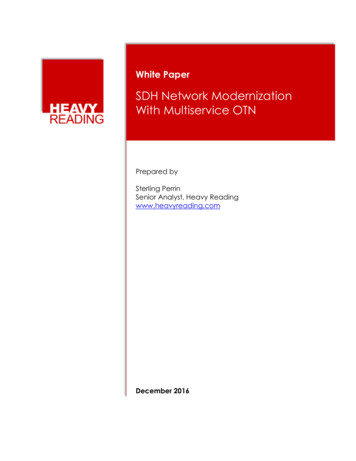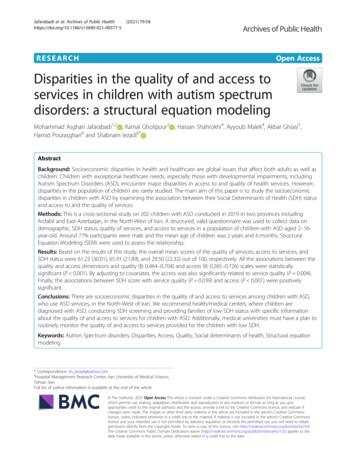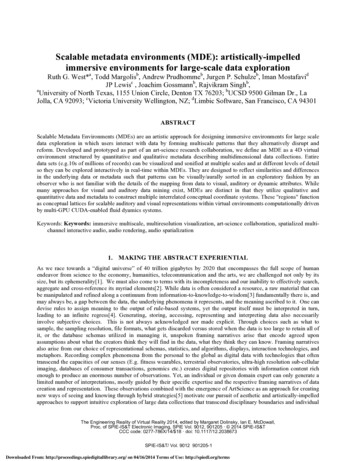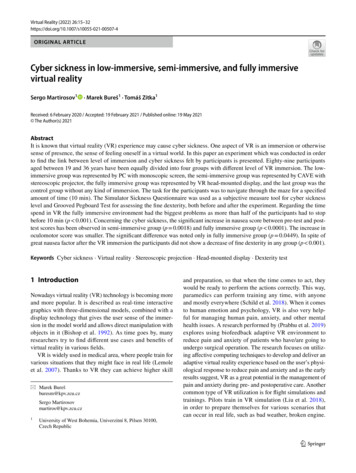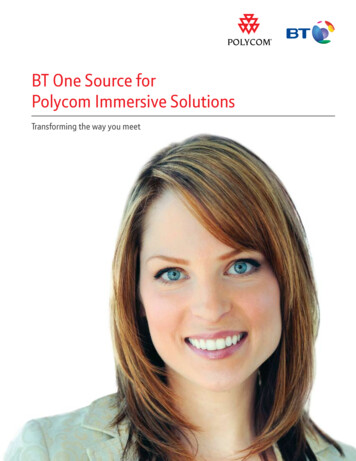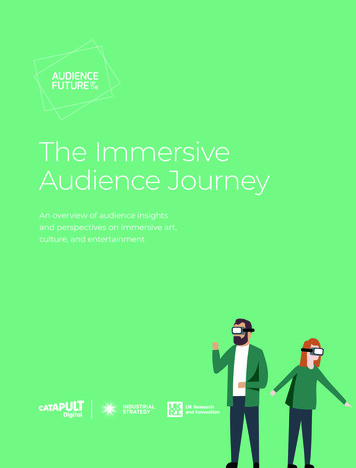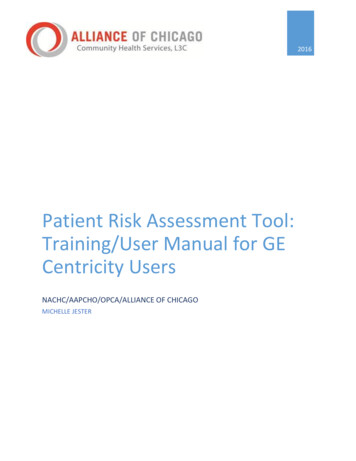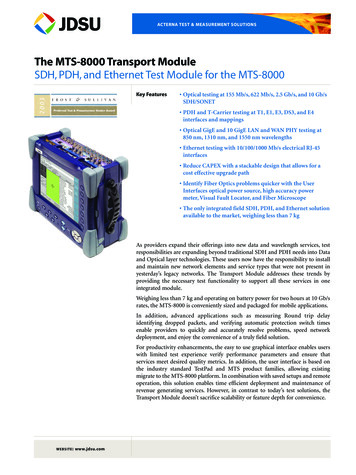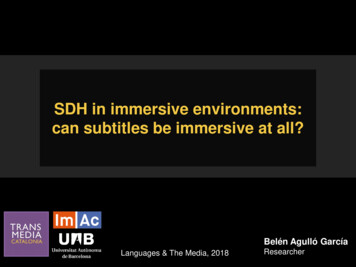
Transcription
SDH in immersive environments:can subtitles be immersive at all?Belén Agulló GarcíaLanguages & The Media, 2018Researcher
Virtual Reality isdangerous.- Steven Spielberg
Content mustbe immersive
cinematicvirtual reality
Real-world imagesstitched together withvideo editing softwarewith a duration from 5to 10 minutes
A new grammarneeds to be createdfor cinematic virtualreality.
Attractingaudience’sattention sound movement and lightning cues moving objects traditional film strategies
GenresJournalistic News Life Stories Documentaries: Travel,History, Culture, ScienceFiction is very limited.
okay, okay but how aboutsubtitles
Position of thesubtitlesSpeaker location
experimentalsolutions
position ofsubtitles
Follow head immediatelyImAc Project – Romeo & Juliet (Liceu Barcelona)
Evenly spacedTNYT – The Displaced 000005005806/the-displaced.html
SpeakerlocationArrowRadarAuto-positioning
Arrow
Radar
Auto-positioning The system takes you automatically to the speaker.
The New YorkTimesBBC
Placement – TNYTPlacement97,20%2,80%EVENLY SPACED FIXED POSITION0%0%FOLLOW HEADIMMEDIATELYOTHER
Position - TNYTPosition54,60%17,60%AT THE TOPAT THEBOTTOM14%MIDDLE OFTHE IMAGE9%4,60%NEXT TO AN NEXT TO THEOBJECT ORSPEAKERPERSON
Placement - BBCPlacement66,70%33,30%FIXED POSITION EVENLY SPACED0%0%FOLLOW HEADIMMEDIATELYOTHER
Position - BBCPosition33,33%AT THE BOTTOM33,33%33,33%NEXT TO THE SPEAKER MIDDLE OF THE IMAGE
No speaker location mechanismfound in NYT VR or BBC!
NYT VR – To main action TNYT VR browser includes a radar that takes theviewer to the main action. 000005005806/the-displaced.html
BBC and TNYTIn some examples,they used the titles toindicate directions.
cansubtitlesbe immersive
“Subtitles will never bedisruptive for those who needthem.
“We just need to find animplementation for subtitles that isimmersive and usable and accessible
what we have learntso far.
accessibility it is possible to integrate text in cinematicvirtual reality content – TNYT & BBC did it! audio cues are a big deal in CVR narrative –speaker location systems are needed!usability make subtitles in immersive media as similar aspossible to traditional subtitles – “follow headimmediately”, according to most users! make subtitles readable: size and backgroundbox at the top or at the bottom or both? we willneed to wait and see how new grammar forCVR content is developed! Loads of testing needed!immersion not disruptive if you need them “suspension of disbelief”
Thank you so com@Belen TranslateBelén Agulló GarcíaLanguages & The Media, 2018Researcher
References Agulló, Belén & Matamala, Anna (forthcoming). “The challenge of subtitling for the deaf and hard-of-hearing in immersiveenvironments: results from a focus group”, Journal of Specialised Translation. Agulló, Belén, Matamala, Anna & Orero, Pilar (forthcoming). “From disabilities to capabilities: testing subtitles in immersiveenvironments with end users”. Agulló, Belén. Making immersive environments accessible for deaf and hard-of-hearing users. 9th International Symposium forYoung Researchers in Translation, Interpreting, Intercultural Studies and East Asian Studies, UAB, Bellaterra (Spain), 29-6-2018. Agulló, Belén, Orero, Pilar and Matamala, Anna, “Implementing subtitles in immersive media for a comfortable reading”, Acceptedas a Poster Presentation, WoRLD-Research perspectives, San Sebastian (Spain), October 2018. Brown, A., Turner, J., Patterson, J., Schmitz, A., Armstrong, M., and Glancy, M. (2018). Exploring Subtitle Behaviour for 360 Video.[White Paper]. Retrieved from 0. Grambart, S. 2015. “Sleepy Hollow & Narrative in VR (Slide Share).” Published on December 10.https://www.slideshare.net/fitc slideshare/sleepy-hollow-narrative-in-vr. Rothe, Sylvia, Heinrich Hussmann, and Mathias Allary. "Diegetic cues for guiding the viewer in cinematic virtual reality."Proceedings of the 23rd ACM Symposium on Virtual Reality Software and Technology. ACM, 2017. Rothe, Sylvia, Heinrich Hussmann, and Mathias Allary. "Diegetic cues for guiding the viewer in cinematic virtual reality."Proceedings of the 23rd ACM Symposium on Virtual Reality Software and Technology. ACM, 2017. Rothe, Sylvia, Heinrich Hussmann. "Guiding the Viewer in Cinematic Virtual Reality by Diegetic Cues" Proceedings of the 5thInternational Conference on Augmented Reality, Virtual Reality, and Computer Graphics. Springer, 2018. Rothe, Sylvia, Kim Tran, Heinrich Hussmann. "Dynamic Subtitles in Cinematic Virtual Reality." Proceedings of the 15th EuropeanInteractive TV Conference (ACM TVX 2018). ACM, 2018. De la Peña, Nonny, Weil, Peggy, Llobera, Joan, Giannopoulos, Elias, Pomés, Ausiàs, Spanlang, Bernhard, Friedman, Doron, SanchezVives, Maria V., and Slater, Mel (2010). “Immersive Journalism: Immersive Virtual Reality for the First-Person Experience of News.”Presence: Teleoperators and Virtual Environments 19(4), 291-301. Kath Dooley (2017) Storytelling with virtual reality in 360-degrees: a new screen grammar, Studies in Australasian Cinema, 11:3,161-171, DOI: 10.1080/17503175.2017.1387357. Mateer, J. 2017. “Directing for Cinematic Virtual Reality: How the Traditional Film Director’s Craft Applies to ImmersiveEnvironments and Notions of Presence.” Journal of Media Practice 18 (1): 14–25. Sheikh, Alia, Brown, Andy, Watson, Zillah and Evans, Michael (2017). “Directing attention in 360-degree video”, IBC 2016. Retrievedfrom: -in-360-degree-video/840.article.
DisclaimerTransMedia Catalonia is a research group funded by Secretaria d’Universitats i Recerca del Departament d’Empresa iConeixement de la Generalitat de Catalunya, reference code 2017SGR113.The project ImAc has received funding from the European Union’s Horizon 2020 Research and Innovation Programme,grant agreement No 761974.Texts, marks, logos, names, graphics, images, photographs, illustrations, artwork, audio clips, video clips, and softwarecopyrighted by their respective owners are used on these slides for personal, educational and non-commercialpurposes only. Use of any copyrighted material is not authorized without the written consent of the copyright holder.Every effort has been made to respect the copyrights of other parties. If you believe that your copyright has beenmisused, please direct your correspondence to: belen.agullo@uab.cat stating your position and we shall endeavour tocorrect any misuse as early as possible.This document and its contents reflect the views only of the authors. TransMedia Catalonia and the European UnionH2020 Research and Innovation Programme cannot be held responsible for any use which may be made of theinformation contained therein.This work is licensed under a Creative Commons Attribution-NonCommercial-NoDerivatives 4.0 International License.
accessibility it is possible to integrate text in cinematic virtual reality content -TNYT & BBC did it! audio cues are a big deal in CVR narrative - speaker location systems are needed! usability make subtitles in immersive media as similar as possible to traditional subtitles -"follow head immediately", according to most users!
